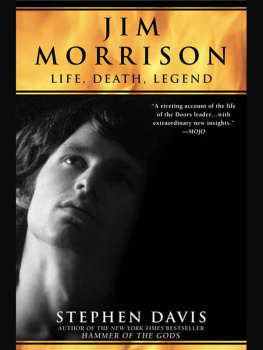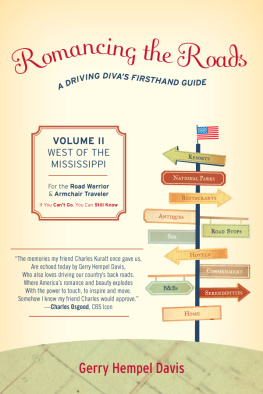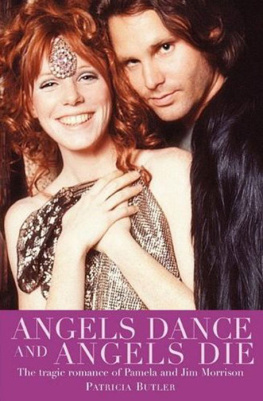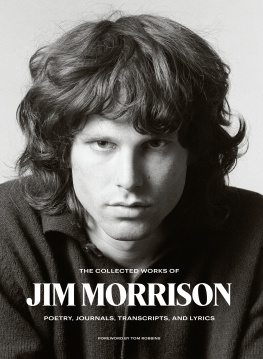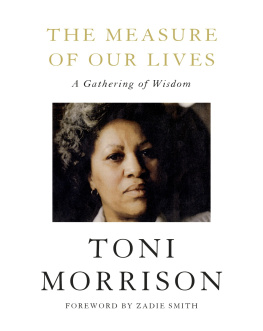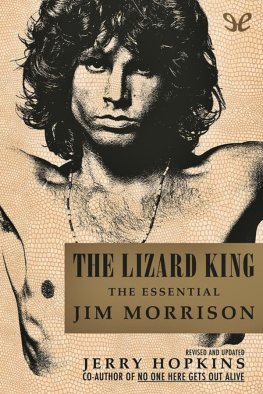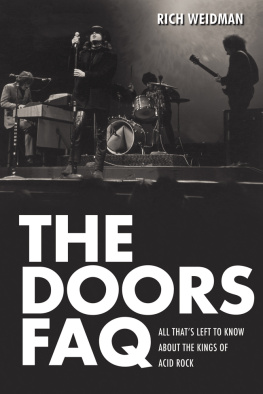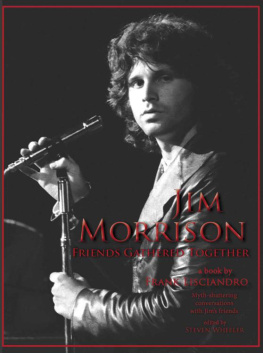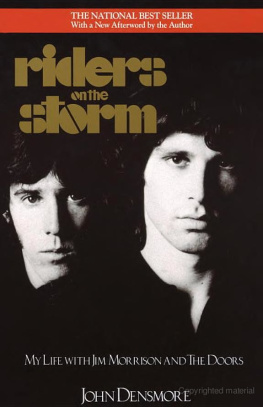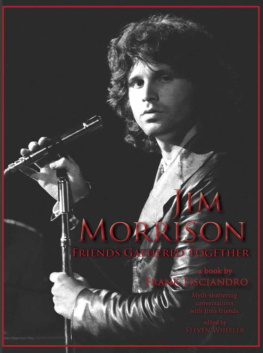GOTHAM BOOKS
Published by Penguin Group (USA) Inc.
375 Hudson Street, New York, New York 10014, U.S.A.
Penguin Books Ltd, Registered Offices: 80 Strand, London WC2R 0RL, England
Penguin Books Australia Ltd, 250 Camberwell Road, Camberwell, Victoria 3124, Australia
Penguin Books Canada Ltd, 10 Alcorn Avenue, Toronto, Ontario, Canada M4V 3B2
Penguin Books (N.Z.) Ltd, Cnr Rosedale and Airborne Roads, Albany, Auckland 1310, New Zealand
Published by Gotham Books, a division of Penguin Group (USA) Inc.
First electronic edition, April 2006
10 9 8 7 6 5 4 3 2 1
Copyright 2004 by Stephen Davis
All rights reserved
Gotham Books and the skyscraper logo are trademarks of Penguin Group (USA) Inc.
LIBRARY OF CONGRESS CATALOGING-IN-PUBLICATION DATA
Davis, Stephen, 1947
Jim Morrison : life, death, legend / by Stephen Davis.
p. cm.
ISBN 978-1-1012-1827-3
Set in Cremona Regular with Trajan and Abbess
Designed by Sabrina Bowers
Without limiting the rights under copyright reserved above, no part of this publication may be reproduced, stored in or introduced into a retrieval system, or transmitted, in any form, or by any means (electronic, mechanical, photocopying, recording, or otherwise), without the prior written permission of both the copyright owner and the above publisher of this book.
The scanning, uploading, and distribution of this book via the Internet or via any other means without the permission of the publisher is illegal and punishable by law. Please purchase only authorized electronic editions, and do not participate in or encourage electronic piracy of copyrighted materials. Your support of the authors rights is appreciated.
Making or distributing electronic copies of this book constitutes copyright infringement and could subject the infringer to criminal and civil liability.
www.us.penguingroup.com
ALSO BY STEPHEN DAVIS
Hammer of the Gods
Walk This Way
Reggae Bloodlines
Reggae International
Bob Marley
Say Kids! What Time Is It?
Moonwalk
Fleetwood
This Wheels on Fire
Jajouka Rolling Stone
Old Gods Almost Dead
For
JIM MORRISON
19431971
KATA TON AIMONA EAYTOY
Ex-fan des sixties
Ou sont tes annes folles?
Que sont devenues toutes tes idoles?
Jane Birkin
H es been dead for decades, but hes still causing trouble.
Jim Morrison was a mesmeric figure in the American sixties, a rebel poet and godhead in snakeskin and leather. He lived fast, died young, and left a less-than-exquisite corpse in Paris while hiding out from the law. In his prime the writers and critics went nuts trying to do his weird mojo some measure of justice. (One called him an angel in grace and a dog in heat.) Jim was the greatest American rock star of his era, and one of its most publicized celebrities, butmore than three decades laterhis life and works have yet to yield all their secrets and enigmas.
Jim Morrison tried to set the night on fire. As lead singer of the Doors, he was an acid evangelist on a suicide mission to deprogram his generation from what he saw as a prisonlike conformity to social and sexual norms. He was a seer, an adept, a bard, a drunk, a bisexual omnivore. Jim styled his band erotic politicians, and relentlessly urged his huge audienceat the height of the dangerous sixtiesto break on through the doors of perception, to free themselves from robotic familial conditioning, to seek a higher, more aware consciousness. Doors concertsthrobbing with war-dance rhythms and superheated intimacywere as close to the experience of shamanic ritual as the rock audience ever got. The Doors captured the unrest and the menace that hung in the air of the late sixties like tear gas, and they did it with hypnotic cool.
Between 1965 and 1971 Jim Morrison wrote a hundred songs, recorded seven platinum albums, wrote and published four editions of poems, made three films, recorded his poetry, wrote screenplays, and filled dozens of notebooks with verse and notations. He played more than two hundred concerts with the Doors. He established himself as a sex icon and the major American rock star of the sixties. He violated all of puritan Americas sexual taboos andin a frenetic burst of political energyeven threatened the vindictive Nixon administration with his blatant invitations to protest and revolt.
Jim Morrison, as it turns out, was much more important than anyone realized at the time. Critically dismissed as a has-been Bozo/Dionysius before his death, Morrisons poetic visions have stayed on the radio for more than thirty years, and on into the new century. They have become the classic texts of classic rock, reaching out to generations beyond the one that first understood the deepest meanings, the organic unity, and the transcendent qualities of his greatest work.
Jim Morrison was the last incarnation of that quintessential late-romantic figure, the demonically aroused poet shaking with rage at his world and his contemporaries; a prophet with terrible eyes and rigid features, clad in black leather. He was arguably the major poet to emerge from the turmoil of the legendary American sixties. Decades later, Jim Morrison has materialized as the true avatar of his age. His words are burned into the brains of three American generationsthe emergency telegram of Break On Through, the visionary cadences of L.A. Woman, and the mysterious whispered verses of Riders on the Storm. His voice echoes on classic-rock stations from coast to coast. His image haunts dorm walls everywhere, emblazoned: JIM MORRISON / AMERICAN POET / 19431971. The Doors album sales, as of this writing, are over fifty million units, and climbing.
Today, more than thirty years after Jim Morrison died, important new revelations are emerging concerning his tumultuous life, his tragic death, and his enduring legend. And the questions about him still linger. Who was he really? Why did he destroy himself? Why was he failed by everyone who knew him?
I t wasnt all great, being a rock god in the sixties. The tours were primitive and disorganized. The groupies were pretty, but they gave you herpes and the clap. The drugs and alcohol turned you into an imbecile. Your old lady slept around while you were on tour. The critics hated you when you got huge, and suddenly the press that had built you up into a deity began to tear you down. The Doors at their best were about as good as rock music ever got. At their worst, they were one of the most pretentious bands on the planet. But no one had a clearer grasp of the complexities and ironies of the age than Jim Morrison.
Living the times as he did, in full senses-deregulated consciousness, Jim understood the American sixties for what they were: an era of new religious visions, spiritual crisis, political unrest, race riots, assassinationsas well as a rare opportunity for change and reform. The decades promises were never fulfilled, but some of its goalssuch as integration, civil rights, the global village, and the bringing of East and West into closer harmonyare clearly still in process. Jim Morrison hitchhiked along this psychic landscape like a killer on the road, and the Doors music still has the uncanny power to poison every new class of ninth graders with its dark messages and raw power. What thirteen-year-old today can play People Are Strange and not hear it as a postcard of comfort from beyond the grave? How many dead rock stars have an annual riot at their tomb?
I n one of his unpublished spiral notebooks, sometime in 1968, Jim penned his credo in blue ink: I contend an abiding sense of irony over all I do.
Jim Morrisons famous Lizard King persona was a joke, but it was a serious joke, a cosmic put-on. Jims serial evocation of the American desert and its reptilian underworld was part of his existential drive to include in the experience of life the omnipresence of impending death. In another notebook entry he wrote: Thinking of death as the climactic point of ones life.

